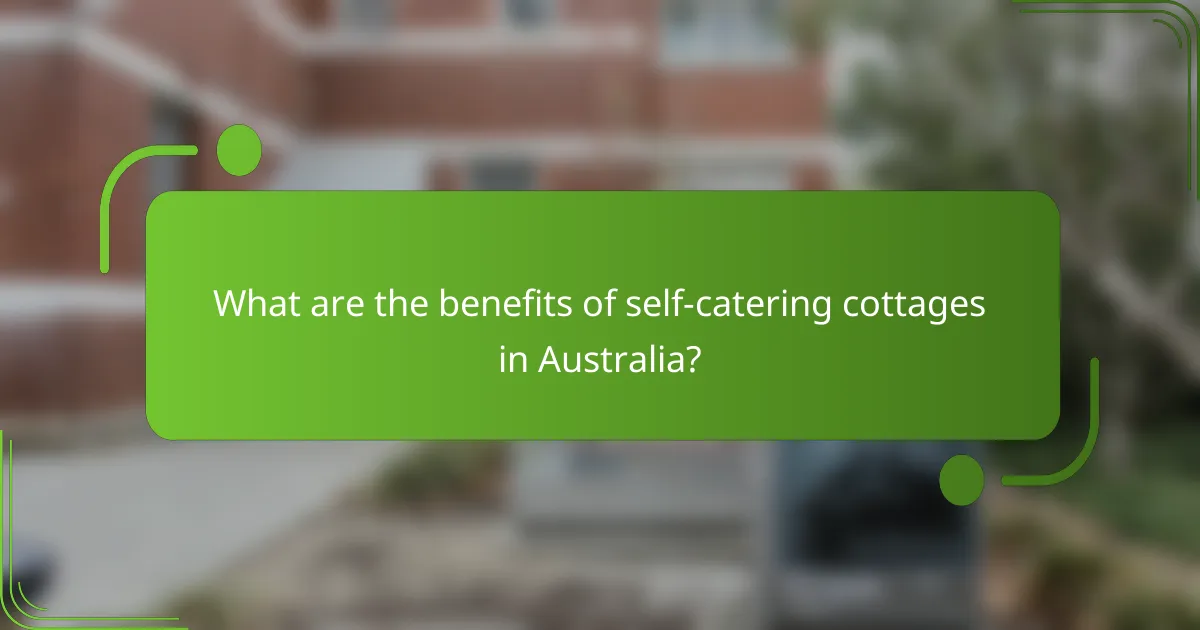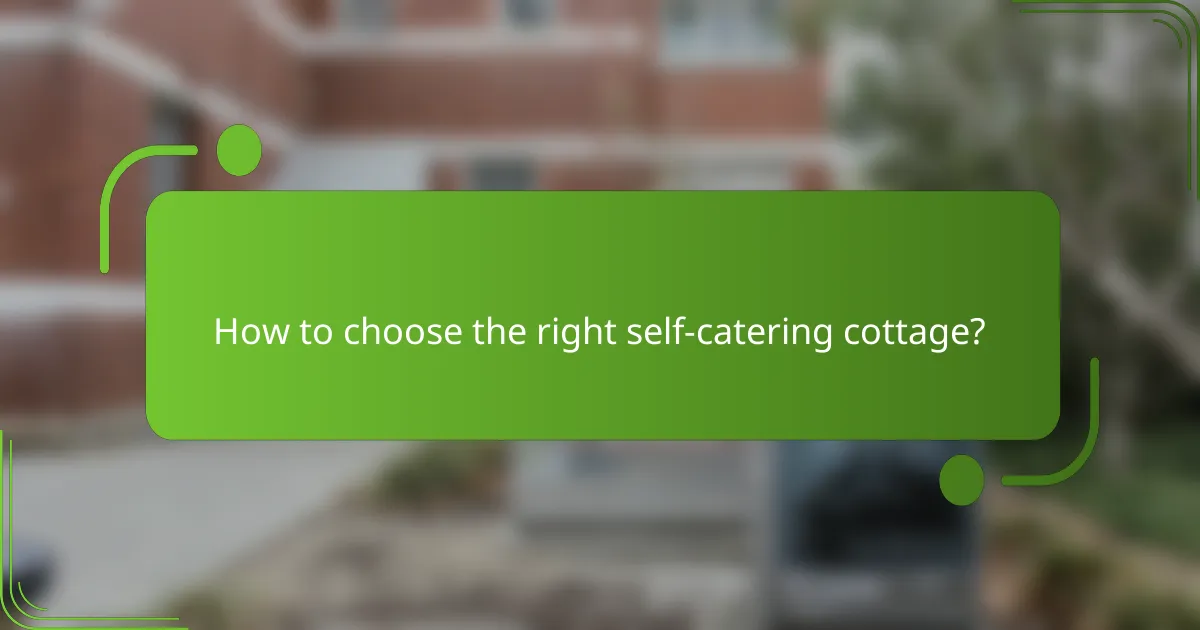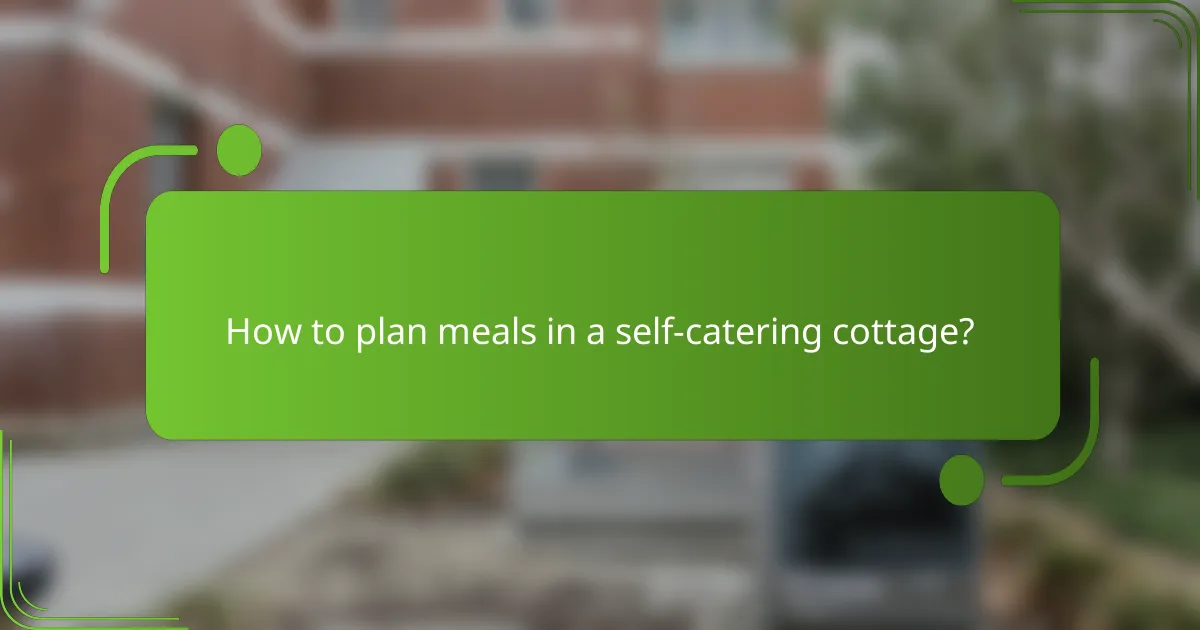Self-catering cottages provide travelers with the perfect blend of flexibility, comfort, and privacy. With the option to prepare your own meals in a home-like setting, these accommodations cater to those seeking a personalized experience away from the hustle and bustle of traditional hotels. Whether nestled in scenic locations or close to popular attractions, self-catering cottages offer a unique way to enjoy your getaway.

What are the benefits of self-catering cottages in Australia?
Self-catering cottages in Australia offer a range of advantages, including flexibility in dining, a comfortable home-like atmosphere, and increased privacy. These features make them an appealing choice for travelers seeking a more personalized experience during their stay.
Flexible dining options
Self-catering cottages allow guests to prepare their own meals, providing the freedom to choose when and what to eat. This flexibility is particularly beneficial for families with varying schedules or dietary preferences.
Equipped with kitchens or kitchenettes, these cottages enable guests to cook using local ingredients, which can enhance the overall experience. Whether it’s a casual breakfast or a family dinner, the choice is entirely yours.
Home-like feel
Staying in a self-catering cottage gives travelers a sense of home away from home. With cozy furnishings and personalized decor, these accommodations often create a warm and inviting atmosphere.
This home-like feel can be especially comforting for families or groups, as it allows for shared moments and bonding time in a relaxed setting. Many cottages also include outdoor spaces, perfect for enjoying the natural surroundings.
Enhanced privacy
Self-catering cottages provide a level of privacy that hotels typically cannot match. Guests can enjoy their own space without the interruptions of hotel staff or other guests.
This privacy is ideal for couples seeking a romantic getaway or families wanting to spend quality time together. You can unwind in your own environment, making it easier to relax and enjoy your vacation.
Cost-effective for families
For families, self-catering cottages can be a more economical choice compared to booking multiple hotel rooms. By preparing meals at home, families can save significantly on dining expenses.
Additionally, many cottages offer competitive rates, especially for longer stays. This affordability allows families to allocate their budget towards activities and experiences rather than accommodation costs.
Access to local markets
Staying in a self-catering cottage often means being close to local markets and grocery stores. This access allows guests to purchase fresh produce and regional specialties, enhancing their culinary experience.
Exploring local markets can also be a fun activity, giving travelers a taste of the local culture. Engaging with vendors and discovering unique ingredients can make meal preparation an enjoyable part of the trip.

How to choose the right self-catering cottage?
Choosing the right self-catering cottage involves considering location, size, amenities, and reviews. Prioritize what matters most to you, whether it’s proximity to attractions or specific facilities that enhance your stay.
Location considerations
Location is crucial when selecting a self-catering cottage. Consider proximity to local attractions, grocery stores, and public transport. A cottage in a quiet area may offer peace, while one closer to the city center provides convenience.
Evaluate the surrounding environment as well. If you prefer nature, look for cottages near parks or beaches. For cultural experiences, choose locations near historical sites or vibrant neighborhoods.
Size and capacity
Determine the size and capacity of the cottage based on your group’s needs. Consider how many bedrooms and bathrooms are necessary for comfort. A larger group may require multiple rooms, while couples might prefer a cozy one-bedroom option.
Also, think about the layout. Open-plan spaces can enhance social interactions, while separate rooms offer privacy. Ensure the cottage can accommodate your group without feeling cramped.
Amenities and facilities
Amenities can significantly enhance your self-catering experience. Look for features like a fully equipped kitchen, laundry facilities, and outdoor spaces. These can make your stay more comfortable and convenient.
Consider additional perks such as Wi-Fi, parking, and entertainment options. Some cottages may offer unique facilities like hot tubs or swimming pools, which can add to your enjoyment.
Reviews and ratings
Reviews and ratings provide valuable insights into the quality of a self-catering cottage. Check platforms like Airbnb or Booking.com for guest feedback on cleanliness, service, and overall experience.
Pay attention to recent reviews, as they reflect the current state of the property. Look for consistent comments about the location and amenities to gauge if the cottage meets your expectations.

What are popular self-catering cottage destinations in Australia?
Australia offers a variety of self-catering cottage destinations that provide flexibility, comfort, and privacy. Popular locations include Byron Bay, the Great Ocean Road, the Blue Mountains, and Margaret River, each offering unique experiences and scenic beauty.
Byron Bay
Byron Bay is renowned for its stunning beaches and vibrant atmosphere, making it a top choice for self-catering cottages. Visitors can enjoy a mix of relaxation and adventure, with options for surfing, hiking, and exploring local markets.
When choosing a cottage in Byron Bay, consider proximity to the beach and local attractions. Many cottages come equipped with kitchens, allowing guests to prepare meals with fresh local produce.
Great Ocean Road
The Great Ocean Road is famous for its breathtaking coastal views and iconic landmarks like the Twelve Apostles. Self-catering cottages along this route provide a perfect base for exploring the natural beauty of the area.
Look for cottages that offer easy access to scenic lookouts and hiking trails. Many accommodations feature outdoor spaces, ideal for enjoying the stunning sunsets over the ocean.
Blue Mountains
The Blue Mountains offer a serene escape with lush landscapes and picturesque views. Self-catering cottages here provide a cozy home-like feel, perfect for families or couples seeking privacy.
When selecting a cottage, consider amenities like fireplaces and outdoor decks. This region is great for bushwalking and exploring local wildlife, making it a fantastic choice for nature enthusiasts.
Margaret River
Margaret River is famous for its wineries and gourmet food scene, making it an excellent destination for self-catering stays. Cottages in this region often feature kitchens stocked with local ingredients, perfect for culinary adventures.
Choose a cottage that allows easy access to vineyards and beaches. Many accommodations also offer outdoor dining areas, enhancing the experience of enjoying local wines and meals in a beautiful setting.

How to plan meals in a self-catering cottage?
Planning meals in a self-catering cottage involves organizing your grocery shopping, meal preparation, and exploring local dining options. This approach allows you to enjoy a home-like feel while maintaining flexibility in your dining choices.
Grocery shopping tips
Start by creating a meal plan for your stay, which will help you determine what groceries to buy. Consider local markets or supermarkets for fresh produce and regional specialties, as prices can vary widely. If you’re traveling in Europe, for instance, look for stores that accept local currencies like EUR or BGN to avoid extra fees.
Make a shopping list based on your meal plan to avoid impulse buys. Focus on versatile ingredients that can be used in multiple dishes, such as pasta, rice, and seasonal vegetables. Don’t forget to check if your cottage has basic pantry staples like oil, salt, and spices.
Meal prep ideas
Meal prep can save time and enhance your self-catering experience. Consider batch cooking meals that can be easily reheated, such as casseroles or soups. These dishes can be stored in the fridge or freezer and enjoyed throughout your stay.
Utilize the cottage kitchen efficiently by prepping ingredients in advance. Chop vegetables, marinate proteins, or cook grains ahead of time. This will make it easier to whip up meals quickly, especially after a day of exploring.
Local dining options
While self-catering offers flexibility, exploring local dining options can enhance your experience. Research nearby restaurants or cafes that showcase regional cuisine, which can provide a taste of the local culture. Many places offer takeout, allowing you to enjoy a meal in the comfort of your cottage.
Check for any local dining deals or specials, which can be a great way to enjoy a meal without overspending. Websites and apps often list popular spots and reviews, helping you make informed choices about where to eat out during your stay.

What are the costs associated with self-catering cottages?
The costs of self-catering cottages vary widely based on location, size, and amenities. Typically, travelers can expect to pay anywhere from a few dozen to several hundred dollars per night, depending on the factors involved.
Rental Rates
Rental rates for self-catering cottages can range significantly. In popular tourist areas, prices may start around $100 per night for basic accommodations, while luxury cottages can exceed $500 per night. Off-peak seasons often provide lower rates, making it more affordable to book a stay.
Additional Costs
In addition to the rental rate, guests should consider other expenses such as cleaning fees, security deposits, and utility costs. Cleaning fees can range from $50 to $150, while security deposits may be equal to one night’s stay. Utilities are often included, but it’s wise to confirm this with the property owner.
Food and Supplies
Self-catering cottages allow guests to prepare their own meals, which can lead to significant savings compared to dining out. Budgeting for groceries is essential; a typical weekly grocery bill might range from $50 to $150 per person, depending on dietary preferences and local prices. Planning meals in advance can help manage costs effectively.
Insurance and Fees
Travelers should also consider travel insurance, which can protect against unforeseen cancellations or damages. Insurance costs vary but typically range from 5% to 10% of the total trip cost. Additionally, some cottages may charge booking fees, so it’s important to read the fine print before finalizing a reservation.
